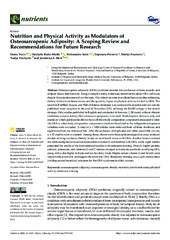Приказ основних података о документу
Nutrition and Physical Activity as Modulators of Osteosarcopenic Adiposity: A Scoping Review and Recommendations for Future Research
| dc.creator | Vučić, Vesna M. | |
| dc.creator | Ristić-Medić, Danijela | |
| dc.creator | Arsić, Aleksandra | |
| dc.creator | Petrović, Snježana | |
| dc.creator | Paunović, Marija | |
| dc.creator | Vasiljević, Nađa | |
| dc.creator | Ilich, Jasminka Z. | |
| dc.date.accessioned | 2023-07-20T09:30:40Z | |
| dc.date.available | 2023-07-20T09:30:40Z | |
| dc.date.issued | 2023 | |
| dc.identifier.issn | 2072-6643 | |
| dc.identifier.uri | http://rimi.imi.bg.ac.rs/handle/123456789/1308 | |
| dc.description.abstract | Osteosarcopenic adiposity (OSA) syndrome denotes the confluence of bone, muscle, and adipose tissue deterioration. Being a complex entity, numerous uncertainties about OSA still exist, despite the extensive research on the topic. Our objectives were to evaluate human studies addressing dietary intake/nutritional status and the quantity/types of physical activity related to OSA. The search in PubMed, Scopus, and Web of Science databases was conducted to examine relevant articles published from inception to the end of December 2022, utilizing the MeSH strings in the search strategy. Only studies published in English and conducted in humans (≥18 years) without chronic conditions (cancers, kidney/liver disease) or pregnancy were used. Book chapters, abstracts-only, and studies in which participants did not have all three body composition components measured to identify OSA or when body composition components could not be related to the independent/exposure variables were excluded. A total of n = 1020 articles were retrieved from all three databases and eight more from the reference lists. After the exclusion of duplicates and other unsuitable articles, n = 23 studies were evaluated. Among those, eleven were from epidemiological or cross-sectional studies relating nutrients/dietary intake or nutritional status with OSA. Another four examined the relationship between serum biomarkers (vitamin D and ferritin) with OSA, while eight articles presented the results of the interventional studies with resistance training. Overall, higher protein, calcium, potassium, and vitamins D and C intakes emerged as nutrients positively modifying OSA, along with a diet higher in fruits and low-fat dairy foods. Higher serum vitamin D and ferritin were respectively positively and negatively related to OSA. Resistance training was a safe intervention yielding several beneficial outcomes for the OSA syndrome in older women. | |
| dc.publisher | Multidisciplinary Digital Publishing Institute (MDPI) | |
| dc.relation | Fulbright Scholar Award Project at the Universityof Belgrade, Serbia: PS00338126, U.S. Department of State Bureau of Education and Cultural Affairs,2022–2023 academic year (JZI) | |
| dc.relation | info:eu-repo/grantAgreement/MESTD/inst-2020/200015/RS// | |
| dc.rights | openAccess | |
| dc.rights.uri | https://creativecommons.org/licenses/by/4.0/ | |
| dc.source | Nutrients | |
| dc.subject | osteosarcopenic adiposity | |
| dc.subject | steosarcopenic obesity | |
| dc.subject | nutrients | |
| dc.subject | nutritional status | |
| dc.subject | physical activity | |
| dc.subject | resistance training | |
| dc.title | Nutrition and Physical Activity as Modulators of Osteosarcopenic Adiposity: A Scoping Review and Recommendations for Future Research | |
| dc.type | article | |
| dc.rights.license | BY | |
| dc.citation.issue | 7 | |
| dc.citation.spage | 1619 | |
| dc.citation.volume | 15 | |
| dc.identifier.doi | 10.3390/nu15071619 | |
| dc.identifier.fulltext | http://rimi.imi.bg.ac.rs/bitstream/id/2980/Nutrition_and_Physical_Activity_as_Modulators_pub_2023.pdf | |
| dc.type.version | publishedVersion |

